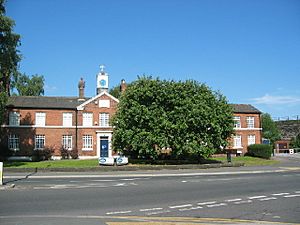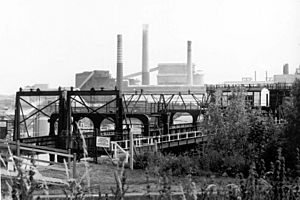History of Northwich facts for kids
The history of Northwich goes way back to Roman times. People have been getting salt from the ground around Northwich for a very long time. Because of all the salt mining, the town has often had problems with the ground sinking, called subsidence. Luckily, a big project has recently helped make the old mines stable.
Northwich is a special kind of town called a wich town in Cheshire, England. It sits in the middle of the Cheshire Plain, right where the River Weaver and the River Dane rivers meet. The town is about 18 kilometres (11 miles) east of Chester and 15 kilometres (9 miles) south of Warrington.
Contents
Roman Northwich: Condate
The first mentions of Northwich are from Roman times. Back then, the town was called Condate. This name probably came from an old British word meaning "Confluence," which means where two rivers join. Northwich is indeed located near where the Dane and Weaver rivers meet.
We know about Roman Northwich from two old Roman documents. One is the Antonine Itinerary, a road map from the 3rd century. It lists Condate as 18 miles from Mamucium (now Manchester) and 20 miles from Deva Victrix (now Chester). Another part of the map also shows Condate 19 miles before Mediolanum (now Whitchurch).
The second document is the Ravenna Cosmography from the 7th century. This document also mentions Condate between Salinae (now Middlewich, Cheshire) and Ratae (now Leicester).
The Romans were interested in Northwich because of its rivers and, most importantly, its salt. Salt was very valuable in Roman society. The word salarium, which is linked to soldiers and pay, might be where our modern word salary comes from!
Archaeologists have found signs of a Roman fort in Northwich, built around 70 AD. This fort and others in the North West were built as the Romans moved north from their main base in Chester.
The fort was on the west side of the River Weaver. Digs started in 1983 and showed two periods of military use. The first was around 70 AD, and the second ended around 140 AD. The fort was smaller during its second use. Excavations found parts of soldier barracks and a courtyard building. This building was likely a Praetorium, which was the commander's house.
The Romans used lead salt pans to get salt from the salty water, called brine. Salt pans and old brine kilns from the 1st century have been found near the Roman fort.
Medieval Salt Town
The name "Northwich" itself shows its connection to salt. The "wich" part of the name is also found in other nearby towns like Middlewich and Nantwich. This word comes from an old Norse word, "wic," meaning bay. It was used for places where salt was made by evaporating seawater. So, a place for making salt became a "wych-house." Northwich was the most northern of these "Wich" towns in Cheshire.
Northwich was important in the early medieval period. It is even mentioned in the Domesday Book from 1086. This book shows that Northwich was making salt and was valued at £8, just like Middlewich. This was less than Nantwich, which was valued at £21. It's not clear if salt making continued without a break from Roman times to the Medieval period.
The land of Northwich belonged to the Earls of Chester. But in 1237, their family line ended. Northwich then became a royal manor. It was given to a noble family to collect taxes in exchange for a set payment to the king. By 1484, the Stanley family, who later became the Earls of Derby, owned it. They kept it until the late 1700s.
Salt production kept going strong for centuries. John Leland's description of the town in 1540 shows this:
Northwich is a pretty market town but dirty,
and by the Salters houses are great piles of small chopped wood,
to boil the salt water that they make white salt of.
Leland called Northwich a market town. Even though there's no old document for a market, a market still happens there today.
During the English Civil War (1642-1643), Northwich was made stronger and guarded by Sir William Bereton for the Parliamentarians.
Salt Rediscovered and Industry Growth
The huge salt beds under Northwich were found again in the 1670s. Workers for the local Smith-Barry family were looking for coal. Instead, they found rock salt on the family's land at Marbury Hall, north of Northwich. Soon, salt mining started up again. This area is now called Dairy House Meadow.
By 1732, the River Weaver was made better for boats. This allowed ships up to 160 tonnes (176 tons) to travel all the way to Northwich Bridge. This meant salt could be moved by boat instead of by cart, which was much easier. The Trent and Mersey Canal opened in 1775. It passed north of Northwich because of disagreements with the Weaver Navigation. However, the canal went past salt deposits near Marston. Many later salt works were built along its banks, including the Lion Salt Works and New Cheshire Salt Works. The amazing Anderton Boat Lift opened in 1875. It connected the canal and river systems, making transport even smoother.
An important change happened when it became too hard to dig for salt. Instead, hot water was pumped into the mines. This dissolved the salt. The salty water (brine) was then pumped out, and the salt was taken from it. This method, however, made the mines weak. It led to the ground sinking, or subsidence, as the mines collapsed.
Subsidence affected the town and the land around it. For example, in 1880, a huge collapse formed Witton Flash when the River Weaver flowed into a giant hole. Subsidence is also why many old timber-framed houses in the town centre are still standing. They were better at moving with the ground. Some houses were even built on steel beams that could be jacked up to keep the house level as the ground shifted. Northwich's long history with salt is celebrated at its Museum. Today, the museum is in the town's old workhouse.
Victorian Expansion and Railways
The 1800s brought big changes to Northwich. A local council was formed in 1863 to manage the original area of Northwich. In 1875, it joined with the larger area of Witton cum Twambrooks. The area grew even more in 1880 to include all of Castle Northwich and parts of Hartford, Winnington and Leftwich. By 1894, these areas became the civil parish of Northwich.
Railways first arrived in Northwich in 1863. A line from Manchester Central was extended from Knutsford. Another extension to Helsby was finished in 1869. These lines are now part of the Mid-Cheshire line.
The Chemical Industry
In 1874, John Brunner and Ludwig Mond started a company called Brunner Mond in Winnington. They began making soda ash, a chemical used in many products, using a method called the Solvay ammonia-soda process. This process needed salt as a main ingredient.
The chemical industry used the sunken land for getting rid of waste from making soda ash. This waste was moved by cranes and rails to create "limebeds." This was a dangerous, alkaline substance. It made the land unusable for a long time.
Brunner Mond later joined with three other chemical companies in 1926. They formed Imperial Chemical Industries, known as ICI. For many years, ICI was one of Europe's top chemical companies.
Land Reclamation
In 1975, Marbury Country Park was the first area to be cleaned up from its industrial past. It has now become a popular place for people to visit and enjoy.
Later, more land was cleaned up. This included Furey Wood and other areas like Anderton Nature Park, Witton Flash, and Dairy House Meadows. Much of the money for these public spaces came from the North West Development Agency. Now, about 323 hectares (800 acres) of public land are known as Northwich Community Woodlands.
Salt Mine Stabilisation Project
In February 2004, a big project started to make the old, abandoned salt mines under Northwich safe. This project cost £28 million. It was paid for by English Partnerships through their Land Stabilisation Programme. This program helps fix problems with unstable mines across England.
Four mines were chosen for the work: Baron's Quay, Witton Bank, Neumann's, and Penny's Lane. These mines were picked because their sinking was causing problems for the town centre.
When the mines were abandoned, they were left with salt pillars to hold them up. In modern salt mining, about 30% of the salt is left for pillars. But in the 19th-century mines under Northwich, sometimes only 5% of the salt was left. This was not enough support. In the 1920s, salty water (brine) was used to fill the mines to help. However, the ground still moved, which stopped new buildings from being built in Northwich town centre.
The current plan involves taking millions of litres of brine out of the four mines. Then, a special mixture of pulverised fuel ash (PFA), cement, and salt is pumped in. The PFA arrives by train, and the cement and salt come by road. This mixture is pumped into the mines through holes drilled into the ground around the town.
The brine that is removed is pumped to Winnington. From there, it's taken by train to British Salt in Middlewich. This brine is then used to make many products, like water softeners and road de-icers.
This important project was finished in late 2007.
Northwich's Future
After the mines were made stable, Northwich began to be developed. This plan is called the 'Vision for Northwich'. If completed, old concrete council buildings and the Magistrates Court will be taken down. They will be replaced with more modern buildings.
New homes continue to be built around Northwich. In 2002, the Drill Field, which was the world's oldest football ground, was taken down. New houses have been built there. This happened after Northwich Victoria football club sold the ground to help with their debts.
A Debenhams store is planned to be built at Barons Quay. There will also be a cinema and 40 new shops.
See also
- Salt in Cheshire
- History of Cheshire



